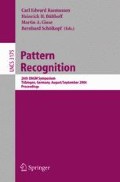Abstract
Irregular pyramids organize a sequence of partitions of images in such a way that each partition is deduced from the preceding one by union of some of its regions. In this paper, we show how a single pyramid can be used to encode redundant subparts of different partitions. We obtain a pyramid that accounts for the redundancy of the partitions. This structure, naturally called the redundancy pyramid, can be used for many purposes. We also demonstrate and discuss some applications for studying image sequences.
This work was supported by the Austrian Science Foundation (FWF) under grants P14445-MAT, P14662-INF and S91 03-N04.
Access this chapter
Tax calculation will be finalised at checkout
Purchases are for personal use only
Preview
Unable to display preview. Download preview PDF.
References
Brun, L., Kropatsch, W.G.: Construction of combinatorial pyramids. In: Proceedings of the 4th IAPR-TC15 Workshop on Graph-based Representations in Pattern Recognition, pp. 1–12 (2003)
Cho, K., Meer, P.: Image segmentation from consensus information. Computer Vision and Image Understanding 68(1), 72–89 (1997)
Förstner, W.: Generic estimation procedures for orientation with minimum redundant information. 2nd Course on Digital Photogrammetry (1999)
Keselman, Y., Dickinson, S.: Generic model abstraction from examples. In: Proc. IEEE Conference CVPR, December 2001, vol. 1, pp. 856–863 (2001)
Kropatsch, W.G.: Abstraction Pyramids on Discrete Representations. In: Braquelaire, A., Lachaud, J.-O., Vialard, A. (eds.) DGCI 2002. LNCS, vol. 2301, pp. 1–21. Springer, Heidelberg (2002)
Marchadier, J., Michelin, S., Arquès, D.: Thinning GrayscaleWell-Composed Images. Pattern Recognition Letters 25, 581–590 (2004)
Author information
Authors and Affiliations
Editor information
Editors and Affiliations
Rights and permissions
Copyright information
© 2004 Springer-Verlag Berlin Heidelberg
About this paper
Cite this paper
Marchadier, J., Kropatsch, W.G., Hanbury, A. (2004). The Redundancy Pyramid and Its Application to Segmentation on an Image Sequence. In: Rasmussen, C.E., Bülthoff, H.H., Schölkopf, B., Giese, M.A. (eds) Pattern Recognition. DAGM 2004. Lecture Notes in Computer Science, vol 3175. Springer, Berlin, Heidelberg. https://doi.org/10.1007/978-3-540-28649-3_53
Download citation
DOI: https://doi.org/10.1007/978-3-540-28649-3_53
Publisher Name: Springer, Berlin, Heidelberg
Print ISBN: 978-3-540-22945-2
Online ISBN: 978-3-540-28649-3
eBook Packages: Springer Book Archive

